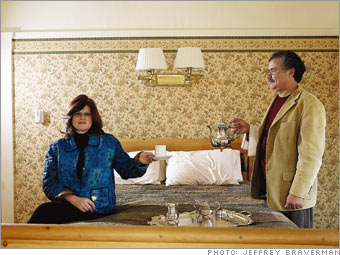And each time, they've toyed with the idea of ditching their corporate careers and joining the innkeeping crowd. (For now, they work at the same hospital; Art in IT and Marta as a finance executive.)
Two years ago, they got serious about their dream. "In health care, people come to you only when they're not feeling well," says Marta. A B&B, by contrast, "is associated with vacations, happiness and good times," adds Art.
THE REALITY
At a three-day innkeeping workshop in June 2005, Art and Marta learned that running a B&B is hard work. "We got the cold hard facts on what it takes," says Art, who vividly remembers the 11-page outline of a typical 16-hour day.
They also learned that the average inn costs $1.2 million and that if they want to derive an income, they need at least eight rooms.
With the $300,000 profit from the recent sale of their house (they're currently renting) and an SBA loan, they should have enough to finance an inn of that size.
They also have another $100,000 in savings set aside for working capital. But most innkeepers plow all profits back into the business, which means Art and Marta will have to adjust to living on a significantly lower income, particularly in the early years.
They don't want to tap pensions or retirement savings for at least a decade.
Can they do it?

